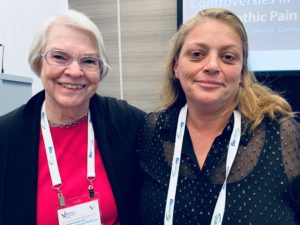This is the fourth report on The 2nd International Annual Congress on Controversies on Cannabis-Based Medicines held May 23-24, 2019 in Barcelona, Spain.
For the past twenty years, the Gallup poll assessing honesty and ethics has found that nurses are the most trusted profession in the United States. That’s a remarkable feat and bodes well for nurses who are choosing to enter the medical cannabis field. And it bodes well for patients that more and more nurses are choosing to enter this remarkably expanding field of medicine.


Israel, of course, is far ahead of nearly every other nation when it comes to integrating cannabis into the medical regimen so it is no surprise that a number of Israeli nurses have become spokespersons for this nation’s medical cannabis program. In Barcelona the conference attendees were fortunate to hear from Miri Ogintz, director of the medical cannabis patient support program of the Rambam Health Care Campus in Haifa, Israel. Miri is also the Nursing Director for Syqe Medical which is testing an innovative inhaler for delivery of medical cannabis. (See Mary’s Prime Time, Issue 2, https://m.aryspub.com/ae5)
Miri’s presentation was well-received by the attendees and the reason is quite simple: she provided practical information that can be easily translated to other countries and programs. Indeed, Miri provided a roadmap for any nurse any where.
She began by laying out the challenges of medical cannabis which included the patient’s misconceptions, the problems with cannabis (lack of standardization and delivery), and clinical practice (titration, adverse events and follow-up). She then presented a six-step program that could be used anywhere. Quite naturally things begin with the medical history and move on to “Expectation Settings.” This step helps both the patient and the nurse as it gives the practitioner a chance to explore the patient’s pre-conceived ideas of cannabis as well as set realistic goals for the therapy.
Step three is to establish a personalized treatment plan. Miri explained that this step can be very time-consuming since patients can have such different reactions to cannabis. It may have been this section that resonated the most loudly with physicians in the audience, many of whom had openly complained that treating patients with cannabis “took too much time.”
Step four is entitled “adverse event management” during which Miri explores, with the patient, the anticipated effects of cannabis (e.g. dizziness, dry mouth, drop in blood pressure, etc.). Step five is “Usage Instructions” during which she covers various delivery methods but also storage of the drug, driving limitations, use during pregnancy and local laws or regulations.
Step six is, according to Miri, among the most important. “Follow-up” with cannabis is more complex than following up with conventional medications. Miri’s schedule recommends day 2, 1st week, 3rd week, 3-4 months, and ten months. Ad-hoc followup is also recommended.
It has been this writer’s good fortune to see several Israeli nurses give presentations. Normally they have focused on patients they have treated and the results of cannabis therapy. Miri’s presentation was refreshing because it focused on the “how” as opposed to “why.” Medical cannabis has matured significantly and while the dramatic stories of patient improvement are always interesting it is important that practitioners be provided with the practical information of how to administer medical cannabis. Conference organizers were wise to invite Nurse Miri Ogintz. ❖
Up Next! “Pediatric Palliative Care and Cannabis,” from the 2nd International Annual Congress on Controversies on Cannabis-Based Medicines.











